Laptop

- This article concerns portable computers, for topics concerning the upper thigh or leg see lap or lap dance.
A laptop computer, also known as a notebook computer, is a small personal computer designed for mobile use. A laptop integrates all of the typical components of a desktop computer, including a display, a keyboard, a pointing device (a touchpad, also known as a trackpad, or a pointing stick) and a battery into a single portable unit. The rechargeable battery is charged from an AC/DC adapter and has enough capacity to power the laptop for several hours.
A laptop is usually shaped like a large notebook with thickness of 0.7–1.5 inches (18–38 mm) and dimensions ranging from 10x8 inches (27x22cm, 13" display) to 15x11 inches (39x28cm, 17" display) and up. Modern laptops weigh 3 to 12 pounds (1.4 to 5.4 kg), and some older laptops were even heavier. Most laptops are designed in the flip form factor to protect the screen and the keyboard when closed.
Originally considered "a small niche market"[1] and perceived as suitable for "specialized field applications" such as "the military, the Internal Revenue Service, accountants and sales representatives"[1][2], battery-powered portables had just 2% worldwide market share in 1986[3]. But today, there are already more laptops than desktops in the enterprise[4] and, according to a forecast by Intel, more laptops than desktops will be sold in the general PC market as soon as 2009[5].
Contents |
History

As the personal computer became feasible in the early 1970s, the idea of a portable personal computer followed; in particular, a "personal, portable information manipulator" was envisioned by Alan Kay at Xerox PARC in 1968[6] and described in his 1972 paper as the "Dynabook"[7].
The first commercially available portable computer appeared nine years later, in 1981. The Osborne 1 weighed 23.5 pounds (10.7 kg). It had no battery, a tiny 5" CRT screen and dual 5¼" single-density floppy drives. In the same year the first laptop-sized portable computer, the Epson HX-20, was announced[8]. The Epson had a LCD screen, a rechargeable battery and a calculator-size printer in a 1.6 kg (4 pounds) enclosure.
The first notebook using the clamshell design, utilized today by almost all laptops, appeared in 1982. The $8150 GRiD Compass 1100 was purchased by NASA and the military among others. The Gavilan SC, released in 1983, was the first notebook marketed using the term "laptop".
From 1983 onwards:
- Several new input methods were introduced: the touchpad (Gavilan SC, 1983), the pointing stick (IBM ThinkPad 700, 1992) and handwriting recognition (Linus Write-Top[9], 1987).
- CPUs became designed specifically for laptops (Intel i386SL, 1990), targeting low power consumption, and were augmented with dynamic power management features (Intel SpeedStep and AMD PowerNow!).
- Displays reached VGA resolution by 1988 (Compaq SLT 286) and 256-color screens by 1993 (PowerBook 165c), progressing quickly to millions of colors and high resolutions.
- High-capacity hard drives and optical storage (CD-ROM followed by DVD) became available in laptops soon after their introduction to the desktops.
Early laptops often had proprietary and incompatible architectures, operating systems and bundled applications.
Classification
The general terms "laptop" or "notebook" can be used to refer to a number of classes of small portable computers:[10][11]
|
By purpose and (approximately) by screen size:
|
By features:
|
Desktop replacement

A desktop replacement computer is a laptop that provides most of the capabilities of a desktop computer, with a similar level of performance. Desktop replacements are usually larger and heavier than standard laptops. They contain more powerful components and numerous ports, and have a 17" or larger display. Because of their bulk, they are not as portable as other laptops and their operation time on batteries is typically shorter.[11]
Some laptops in this class use a limited range of desktop components to provide better performance for the same price at the expense of battery life; in a few of those models, there is no battery at all, and the laptop can only be used when plugged in. These are sometimes called desknotes, a portmanteau of the words "desktop" and "notebook," though the term can also be applied to desktop replacement computers in general.[12]
The names "Media Center Laptops" and "Gaming Laptops" are also used to describe this class of notebooks.[10]
Subnotebook
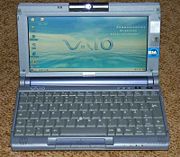
A subnotebook, also called an ultraportable by some vendors, is a laptop designed and marketed with an emphasis on portability (small size, low weight and long battery life) that retains the performance of a standard notebook. Subnotebooks are usually smaller and lighter than standard laptops, weighing between 0.8 and 2 kg (2 to 5 pounds)[10]; the battery life can exceed 10 hours[13] when a large battery or an additional battery pack is installed.
To achieve the size and weight reductions, ultraportables use high resolution 13" and smaller screens (down to 6.4"), have relatively few ports, employ expensive components designed for minimal size and best power efficiency, and utilize advanced materials and construction methods. Some subnotebooks achieve a further portability improvement by omitting an optical/removable media drive; in this case they may be paired with a docking station that contains the drive and optionally more ports or an additional battery.
The term "subnotebook" is usually reserved to laptops that run general-purpose desktop operating systems such as Windows, Linux or Mac OS X, rather than specialized software such as Windows CE, Palm OS or Internet Tablet OS.
Netbook

A netbook is a small laptop designed for portability and low price, with a performance inferior to that of a standard notebook yet adequate for surfing on the Internet and basic word processing. Netbooks use 10" and smaller screens, weigh 0.6 to 1.2 kg (1.5 to 3 pounds), and are generally powered by a CPU from one of the low-cost families with a high performance-to-power ratio such as Intel Atom, Celeron ULV, or VIA C7 processors.[14]
Netbooks use general-purpose operating systems such as Linux or Windows XP. Some models use small-capacity (4 to 40 Gb) SSD drives instead of the usual HDDs to save weight and battery power.
Rugged Laptop
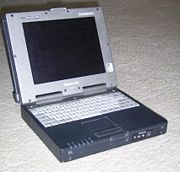
A rugged (or ruggedized) laptop is designed to reliably operate in harsh usage conditions such as strong vibrations, extreme temperatures and wet or dusty environments. Rugged laptops are usually designed from scratch, rather than adapted from regular consumer laptop models. Rugged notebooks are bulkier, heavier, and much more expensive than regular laptops[15], and thus are seldom seen in regular consumer use.
The design features found in rugged laptops include rubber sheeting under the keyboard keys, sealed port and connector covers, passive cooling, superbright displays easily readable in daylight, cases and frames made of magnesium alloys or have a magnesium alloy rollcage[16] that are much stronger than plastic found in commercial laptops and solid-state storage devices or hard disc drives that are shock mounted to withstand constant vibrations. Rugged laptops are commonly used by public safety services (police, fire and medical emergency), military, utilities, field service technicians, construction, mining and oil drilling personnel. Rugged laptops are usually sold to organizations, rather than individuals, and are rarely marketed via retail channels.
Components

The basic components of laptops are similar in function to their desktop counterparts, but are miniaturized, adapted to mobile use, and designed for low power consumption. Because of the additional requirements, laptop components have worse performance than desktop parts of comparable price. Furthermore, the design bounds on power, size, and cooling of laptops limit the maximum performance of laptop parts compared to that of desktop components. [17]
The following list summarizes the differences and distinguishing features of laptop components in comparison to desktop personal computer parts:
- Motherboard - laptop motherboards are highly make- and model-specific, and do not conform to a desktop form factor. Unlike a desktop board that usually has several slots for expansion cards (3 to 7 are common), a board for a small, highly integrated laptop may have no expansion slots at all, with all the functionality implemented on the motherboard itself; the only expansion possible in this case is via an external port such as USB. Other boards may have one or more standard or proprietary expansion slots. Several other functions (storage controllers, networking, sound card and external ports) are implemented on the motherboard.[18]
- Central processing unit (CPU) - Laptop CPUs have advanced power-saving features and produce less heat than desktop processors, but are not as powerful.[19] There is a wide range of CPUs designed for laptops available from Intel (Pentium M, Celeron M, Intel Core and Core 2 Duo), AMD (Athlon, Turion 64, and Sempron), VIA Technologies, Transmeta and others. On the non-x86 architectures, Motorola and IBM produced the chips for the former PowerPC-based Apple laptops (iBook and PowerBook). Some laptops have removable CPUs, although support by the motherboard may be restricted to the specific models.[20] In other laptops the CPU is soldered on the motherboard and is non-replaceable.
- Memory (RAM) - SO-DIMM memory modules that are usually found in laptops are about half the size of desktop DIMMs.[18] They may be accessible from the bottom of the laptop for ease of upgrading, or placed in locations not intended for user replacement such as between the keyboard and the motherboard.
- Expansion cards - A PC Card (formerly PCMCIA) or ExpressCard bay for expansion cards is often present on laptops to allow adding and removing functionality, even when the laptop is powered on. Some subsystems (such as Wi-Fi or a cellular modem) can be implemented as replaceable internal expansion cards, usually accessible under an access cover on the bottom of the laptop. Two popular standards for such cards are MiniPCI and its successor, the PCI Express Mini. [21]
- Power supply - laptops are powered by an internal rechargeable battery that is charged using an external power supply. The power supply can charge the battery and power the laptop simultaneously; when the battery is fully charged, the laptop continues to run on AC power. The charger adds about 400 grams (1 lb) to the overall "transport weight" of the notebook.
- Battery - Current laptops utilize lithium ion batteries, with more recent models using the new lithium polymer technology. These two technologies have largely replaced the older nickel metal-hydride batteries. Typical battery life for standard laptops is two to five hours of light-duty use, but may drop to as little as one hour when doing power-intensive tasks. Batteries' performance gradually decreases with time, leading to an eventual replacement in one to five years, depending on the charging and discharging pattern. This large-capacity main battery should not be confused with the much smaller battery nearly all computers use to run the real-time clock and to store the BIOS configuration in the CMOS memory when the computer is off.
- Video display controller - on standard laptops video controller is usually integrated into the chipset. This tends to limit the use of laptops for gaming and entertainment, two fields which have constantly escalating hardware demands[22]. Higher-end laptops and desktop replacements in particular often come with dedicated graphics processors on the motherboard or as an internal expansion card. These mobile graphics processors are comparable in performance to mainstream desktop graphic accelerator boards.[23]
- Display - Most modern laptops feature 12 inch (30 cm) or larger color active matrix displays with resolutions of 1024×768 pixels and above. Many current models use screens with higher resolution than typical for desktop PCs (for example, the 1440×900 resolution of a 15" Macbook Pro[24] can be found on 19" widescreen desktop monitors).

- Removable media drives - a DVD/CD reader/writer drive is standard. CD drives are becoming rare, while Blu-Ray is not yet common on notebooks[25]. Many ultraportables and netbooks either move the removable media drive into the docking station or exclude it altogether.
- Internal storage - Hard disks are physically smaller—2.5 inch (60 mm) or 1.8 inch (46 mm) —compared to desktop 3.5 inch (90 mm) drives. Some new laptops (usually ultraportables) employ more expensive, but faster, lighter and power-efficient Flash memory-based SSDs instead. Currently, 160 to 250 Gb sizes are common for laptop hard disks (64 to 128 Gb for SSDs).
- Input - A pointing stick, touchpad or both are used to control the position of the cursor on the screen, and an integrated keyboard is used for typing. External keyboard and mouse may be connected using USB or PS/2 (if present).
- Ports - several USB ports, an external monitor port (VGA or DVI), audio in/out, and an Ethernet network port are found on most laptops. Less common are legacy ports such as a PS/2 keyboard/mouse port, serial port or a parallel port. S-video or composite video ports are more common on consumer-oriented notebooks.
Docking stations
A docking station is a relatively bulky laptop accessory that contains multiple ports, expansion slots and bays for fixed or removable drives. A laptop connects and disconnects easily to a docking station, typically through a single large proprietary connector. A port replicator is a simplified docking station that only provides connections from the laptop to input/output ports. Both docking stations and port replicators are intended to be used at a permanent working place (a desk) to offer instant connection to multiple input/output devices and to extend a laptop's capabilities.
Docking stations became a common laptop accessory in the early 1990s. The most common use was in a corporate computing environment where the company had standardized on a common network card and this same card was placed into the docking station. These stations were very large and quite expensive. As the need for additional storage and expansion slots became less critical because of the high integration inside the laptop, the "port replicator" has gained popularity. The port replicator was a cheaper, often passive device that simply mated to the connectors on the back of the notebook and allowed the user to quickly connect his laptop so that his monitor, keyboard, printer and other devices were instantly attached. As higher speed ports such as USB and Firewire became common, the connection of a port replicator to a laptop was accomplished by a small cable connected to one of the USB or FireWire ports on the notebook. Wireless Port Replicators are available as well.
A recent variant of the port replicator is the combined power/display/USB hub cable found in the new Apple Cinema Display[26].
Standards
Some laptop components (optical drives, hard drives, memory and internal expansion cards) are relatively standardized, and it is possible to upgrade or replace them in many laptops as long as the new part is of the same type.[21] Subtle incompatibilities and variations in dimensions, however, are not uncommon.[27] Depending on the manufacturer and model, a laptop may range from having several standard, easily customizable and upgradeable parts to a proprietary design that can't be reconfigured at all.
In general, components other than the four categories listed above are not intended to be replaceable, and thus rarely follow a standard. In particular, motherboards, locations of ports, design and placement of internal components are usually make- and model-specific. Those parts are neither interchangeable with parts from other manufacturers nor upgradeable. If broken or damaged, they must be substituted with an exact replacement part. The users uneducated in the relevant fields are those the most affected by incompatibilities, especially if they attempt to connect their laptops with incompatible hardware or power adapters.
Intel, Asus, Compal, Quanta and other laptop manufacturers have created the Common Building Block standard for laptop parts to address some of the inefficiencies caused by the lack of standards.
Advantages

Portability is usually the first feature mentioned in any comparison of laptops versus desktop PCs[28]. Portability means that a laptop can be used in many places - not only at home and at the office, but also during commuting and flights, in coffee shops, in lecture halls and libraries, at clients' location or at a meeting room, etc. The portability feature offers several distinct advantages:
- Getting more done - using a laptop in places where a desktop PC can't be used, and at times that would otherwise be wasted. For example, an office worker tackling his e-mails during a hour-long commute by train, or a student doing her homework at the university coffee shop during a break between lectures.[29]
- Immediacy - Carrying a laptop means having instant access to various information, personal and work files. Immediacy allows better collaboration between coworkers or students, as a laptop can be flipped open to present a problem or a solution anytime, anywhere.
- Up-to-date information - If a person has more than one desktop PC, a problem of synchronization arises: changed made on one computer are not automatically propagated to the others. There are ways to resolve this problem, including physical transfer of updated files (using a USB stick or CDs) or using synchronization software over the Internet. However, using a single laptop at both locations avoids the problem entirely, as the files exist in a single location and are always up-to-date.
- Connectivity - A proliferation of Wi-Fi wireless networks and cellular broadband data services (HSDPA, EVDO and others) combined with a near-ubiquitous support by laptops [30] means that a laptop can have easy Internet and local network connectivity while remaining mobile. Wi-Fi networks and laptop programs are especially widespread at university campuses.[31]
Other advantages of laptops include:
- Size - laptops are smaller than standard PCs. This is beneficial when space is at a premium, for example in small apartments and student dorms. When not in use, a laptop can be closed and put away.
- Low power consumption - laptops are several times more power-efficient than desktops. A typical laptop uses 20-90 W, compared to 100-800 W for desktops. This could be particularly beneficial for businesses (which run hundreds of personal computers, multiplying the potential savings) and homes where there is a computer running 24/7 (such as a home media server, print server, etc.)
- Quiet - laptops are often quieter than desktops, due both to better components (quieter, slower 2.5-inch hard drives) and to less heat production leading to use of fewer and slower cooling fans.
- Battery - a charged laptop can run several hours in case of a power outage and is not affected by short power interruptions and brownouts. A desktop PC needs a UPS to handle short interruptions, brownouts and spikes; achieving on-battery time of more than 20-30 minutes for a desktop PC requires a large and expensive UPS.[32]
Disadvantages
Compared to desktop PCs, laptops have disadvantages in the following fields:
Performance
While the performance of mainstream desktops and laptops is comparable, laptops are significantly more expensive than desktop PCs at the same performance level.[33] The upper limits of performance of laptops are lower, and "bleeding-edge" features usually appear first in desktops and only then, as the underlying technology matures, are adapted to laptops.
However, for Internet browsing and typical office applications, where the computer spends the majority of its time waiting for the next user input, even netbook-class laptops are generally fast enough.[34] Standard laptops are sufficiently powerful for high-resolution movie playback and light gaming. 3D gaming, video editing and encoding, and number-crunching software (databases, math, engineering, financial, etc.) are the areas where the laptops are at the biggest disadvantage.
Upgradeability
Upgradeability of laptops is very limited compared to desktops, which are thoroughly standardized. In general, hard drives and memory can be upgraded easily. Optical drives and internal expansion cards may be upgraded if they follow an industry standard, and all other internal components, including the CPU and graphics, are not intended to be upgradeable.
The reasons for limited upgradeability are both technical and economic. There is no industry-wide standard form factor for laptops; each major laptop manufacturer pursues its own proprietary design and construction, with the result that laptops are difficult to upgrade and have high repair costs. With few exceptions, laptop components can rarely be swapped between laptops of competing manufacturers, or even between laptops from the different product-lines of the same manufacturer.
Some upgrades can be performed by adding external devices, either USB or in expansion card format such a PC Card: sound cards, network adapters, hard and optical drives, and numerous other peripherals are available. But those upgrades usually impair the laptop's portability, because they add cables and boxes to the setup and often have to be disconnected and reconnected when the laptop is moved.
Ergonomics and health

Because of their small and flat keyboard and trackpad pointing devices, prolonged use of laptops can cause RSI.[35] Usage of ergonomic keyboards and pointing devices is recommended to prevent injury when working for long periods of time; they can be connected to a laptop easily by USB or via a docking station. Some health standards require ergonomic keyboards at workplaces.
The integrated screen often causes users to hunch over for a better view, which can cause neck or spinal injuries. A larger and higher-quality external screen can be connected to almost any laptop to alleviate that and to provide additional "screen estate" for more productive work.
A study by State University of New York researchers found that heat generated from laptops can raise the temperature of the scrotum, potentially putting sperm count at risk. The small study, which included little more than two dozen men aged 13 to 35, found that the sitting position required to balance a laptop can raise scrotum temperature by as much as 2.1 °C (3.8 °F). Heat from the laptop itself can raise the temperature by another 0.7 °C (1.4 °F), bringing the potential total increase to 2.8 °C (5.2 °F). However, further research is needed to determine whether this directly affects sterility in men.[36] A common practical solution to this problem is to place the laptop on a table or desk.
Heat from using a laptop on the lap can also cause skin discoloration on the thighs.[37]
Durability

Due to their portability, laptops are subject to more wear and physical damage than desktops. Components such as screen hinges, latches, power jacks[38] and power cords deteriorate gradually due to ordinary use. A liquid spill onto the keyboard, a rather minor mishap with a desktop system, can damage the internals of a laptop and result in a costly repair. One study found that a laptop is 3 times more likely to break during the first year of use than a desktop.[39]
Original external components are expensive (a replacement AC adapter, for example, could cost $75); other parts are inexpensive - a power jack can cost a few dollars - but their replacement may require extensive disassembly and reassembly of the laptop by a technician. Other inexpensive but fragile parts often cannot be purchased separate from larger more expensive components.[40] The repair costs of a failed motherboard or LCD panel may exceed the value of a used laptop.
Laptops rely on extremely compact cooling systems involving a fan and heat sink that can fail due to eventual clogging by accumulated airborne dust and debris. Most laptops do not have any sort of removable dust collection filter over the air intake for these cooling systems, resulting in a system that gradually runs hotter and louder as the years pass. Eventually the laptop starts to overheat even at idle load levels. This dust is usually stuck inside where casual cleaning and vacuuming cannot remove it. Instead, a complete disassembly is needed to clean the laptop.
Battery life of laptops is limited; the capacity drops with time, necessitating an eventual replacement after a few years.
Security
Being expensive, common and portable, laptops are prized targets for theft. The cost of the stolen business or personal data and of the resulting problems (identity theft, credit card fraud, breach of privacy laws) can be many times the value of the stolen laptop itself. Therefore, both physical protection of laptops and the safeguarding of data contained on them are of the highest importance.
Most laptops have a Kensington security slot which is used to tether the computer to a desk or other immovable object with a security cable and lock. In addition to this, modern operating systems and third-party software offer disk encryption functionality that renders the data on the laptop's hard drive unreadable without a key or a passphrase.
Other portable computing devices
There are several categories of portable computing devices that can run on batteries but are not usually classified as laptops: portable computers, keyboardless tablet PCs, Internet tablets, PDAs, handheld computers (UMPCs) and smartphones.
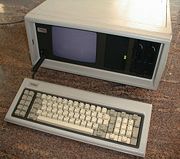
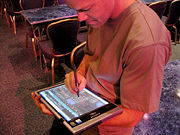
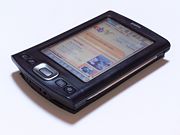



A Portable computer is a general-purpose computer that can be easily moved from place to place, but cannot be used while in transit, usually because it requires some "setting-up" and an AC power source. The most famous example is the Osborne 1. Also called a "transportable" or a "luggable" PC.
A Tablet PC that lacks a keyboard (also known as a non-convertible Tablet PC) is shaped like slate or a paper notebook, features a touchscreen with a stylus and handwriting recognition software. Tablets may not be best suited for applications requiring a physical keyboard for typing, but are otherwise capable of carrying out most tasks that an ordinary laptop would be able to perform.
An Internet tablet is an Internet appliance in tablet form. Unlike a Tablet PC, an Internet tablet does not have much computing power and its applications suite is limited - it can not replace a general purpose computer. Internet tablets typically feature an MP3 and video player, a web browser, a chat application and a picture viewer.
A Personal digital assistant (PDA) is a small, usually pocket-sized, computer with limited functionality. It is intended to supplement and to synchronize with a desktop computer, giving access to contacts, address book, notes, e-mail and other features.
A Handheld computer, also known as an Ultra Mobile PC (UMPC) is a full-featured, PDA-sized computer running a general-purpose operating system.
A Smart phone is a PDA with an integrated cellphone functionality. Current smartphones have a wide range of features and installable applications.
Boundaries that separate these categories are blurry at times. For example, the OQO UMPC is also a PDA-sized tablet PC; the Apple eMate had the clamshell form factor of a laptop, but ran PDA software. The HP Omnibook line of laptops included some devices small enough to be called handheld computers. The hardware of the Nokia 770 internet tablet is essentially the same as that of a PDA such as the Zaurus 6000; the only reason it's not called a PDA is that it doesn't have PIM software. On the other hand, both the 770 and the Zaurus can run some desktop Linux software, usually with modifications.
Major brands and manufacturers
|
There is a multitude of laptop brands and manufacturers; several major brands, offering notebooks in various classes, are listed in the box to the right. The major brands usually offer good service and support, including well-executed documentation and driver downloads that will remain available for many years after a particular laptop model is no longer produced. Capitalizing on service, support and brand image, laptops from major brands are more expensive than laptops by smaller brands and ODMs. Some brands are specializing in a particular class of laptops, such as gaming laptops (Alienware), netbooks (EeePC) and laptops for children (OLPC). Many brands, including the major ones, do not design and do not manufacture their laptops. Instead, a small number of Original Design Manufacturers (ODMs) design new models of laptops, and the brands choose the models to be included in their lineup. In 2006, 7 major ODMs manufactured 7 of every 10 laptops in the world, with the largest one (Quanta Computer) having 30% world market share.[41] Therefore, there often are identical models available both from a major label and from a low-profile ODM in-house brand. |
See also
- Desktop computer
- List of computer size categories
- Palmtop
- Personal computer
- Ultra-Mobile PC
- NEC UltraLite
References
- ↑ 1.0 1.1 Sandberg-Diment, Erik (December 8, 1985). "The Executive Computer", The New York Times. Retrieved on 11/01/2008.
- ↑ Lewis, Peter H. (April 15, 1986). "PERIPHERALS; NEW PORTABLE FROM I.B.M." (in en), The New York Times. Retrieved on 11/01/2008.
- ↑ "LAP-TOP COMPUTERS GAIN STATURE AS POWER GROWS" (in en), Daily News of Los Angeles (CA) (April 12, 1987). Retrieved on 11/01/2008.
- ↑ "The Falling Costs of Mobile Computing". Falling Costs of Mobile Computing Drive Corporate Adoption. Computer Economics, Inc. (December, 2005). Retrieved on 11/01/2008.
- ↑ "Intel: laptop/desktop crossover coming sooner than expected". The Register, UK. Retrieved on 2008-10-10.
- ↑ John W. Maxwell. "Tracing the Dynabook: A Study of Technocultural Transformations" (PDF). Retrieved on 2008-10-17.
- ↑ Alan C. Kay. "A Personal Computer for Children of All Ages" (PDF). Retrieved on 2008-10-17.
- ↑ "Epson SX-20 Promotional Brochure". Epson America, Inc. (1987). Retrieved on 2008-11-02.
- ↑ "Linus Write-Top". Retrieved on 2008-10-18.
- ↑ 10.0 10.1 10.2 "Types of Laptops: How Do You Compute". PC Magazine. Ziff Davis Publishing Holdings Inc. (2006-09-18). Retrieved on 2008-11-07.
- ↑ 11.0 11.1 "Laptop Buying Guide". CBS Interactive Inc.. Retrieved on 2008-11-07.
- ↑ "Desktop notebooks stake their claim". CBS Interactive Inc. (2003-01-08). Retrieved on 2008-11-07.
- ↑ "Breaking the Mold: New Lenovo ThinkPad Notebook and Tablet PCs Defy Ultraportable Computing". Lenovo (2008-09-23). Retrieved on 2008-11-07.
- ↑ "What is a Netbook computer?". Defensive Computing. CBS Interactive Inc. (2008-10-12). Retrieved on 2008-11-07.
- ↑ "Rugged Laptop: Choices, Pointers & Specs of Buying Rugged Laptops". linux-on-laptops.com. Retrieved on 2008-11-27.
- ↑ "The only laptop with a magnesium alloy rollcage".
- ↑ For an example, on a CPU-intensive task (video encoding), the fastest-performing mobile CPU as of early 2008 (Intel Core 2 Extreme X7800, 2.6 GHz) performed about 30% worse than the slowest-performing desktop CPU (AMD Sempron 64 3000+, at 1.6 GHz) in the surveyed selection. "Mobile CPU charts". Tom's Hardware (2008). Retrieved on 2008-11-12. "CPU charts Q1/2008". Tom's Hardware (2008). Retrieved on 2008-11-12.
- ↑ 18.0 18.1 Catherine Roseberry. "What Makes Laptops Work - The Laptop Motherboard". About.com. Retrieved on 2008-11-15.
- ↑ "Laptop Buyer's Guide" (2008). Retrieved on 2008-11-15.
- ↑ The socketed CPUs are perhaps for the manufacturer's convenience, rather than the end-user, as few manufacturers try new CPUs in last year's laptop models with an eye toward selling upgrades rather than new laptops.
- ↑ 21.0 21.1 Gabriel Torres (2004-11-25). "Innovations in Notebook Expansion". Hardware Secrets, LLC. Retrieved on 2008-11-15.
- ↑ "Game Hardware". Retrieved on 2008-05-10.
- ↑ Dustin Sklavos (2006-07-18). "Notebook Video Graphics Card Guide 2006". NotebookReview.com. Retrieved on 2008-11-15.
- ↑ "Macbook Pro - Technical Specifications". Apple Inc. (2008). Retrieved on 2008-11-12.
- ↑ "Acer: BD notebooks to account for 10% of shipments in 2008". Digitimes (2008-04-02). Retrieved on 2008-11-12.
- ↑ "LED Cinema Display - Features". Apple Inc. (2008). Retrieved on 2008-11-12.
- ↑ "Tips for buying a new notebook DVD drive". Laptop Repair Help. Retrieved on 2008-11-15.
- ↑ "Should I buy a laptop or desktop?". IT Division - University of Wisconsin (2008-03-19). Retrieved on 2008-11-27.
- ↑ "ECU Advantage: Why have a laptop?". ECU. Retrieved on 2008-11-27.
- ↑ Almost all laptops contain a Wi-Fi interface; broadband cellular devices are available widely as extension cards and USB devices, and also as internal cards in select models.
- ↑ Josh Fischman (2008-08-07). "Faster Wi-Fi Predicted for Colleges". The Chronicle of Higher Education. Retrieved on 2008-11-27.
- ↑ A sample line of UPS devices and on-battery power: "Back-UPS® RS". APC. Retrieved on 2008-11-27.
- ↑ In a comparison between laptop and desktop of equal cost, the desktop's System Benchmark Score was twice that of the laptop. "What to Buy, a Notebook or Desktop PC?". Tom's Hardware (2008-06-11). Retrieved on 2008-11-28.
- ↑ For example, a review of MSI Wind says that "The device is rarely sluggish in general use. It renders Web pages quickly, launches most applications without becoming too bogged down and generally doesn't feel like it's a budget laptop." Reid, Rory (2008-07-07). "MSI Wind Review". CNET Australia. Retrieved on 2008-11-28.
- ↑ Martin, James A. (2000-06-09). "The Pain of Portable Computing". PC World. Retrieved on 2008-11-27.
- ↑ Sheynkin, Y.; Jung M;Yoo P;Schulsinger D;Komaroff E (2004-12-09). "Increase in scrotal temperature in laptop computer users". Human Reproduction (Epub) 20 (2): 452–5. doi:. PMID 15591087.
- ↑ Levinbook, WS.; Mallet J; Grant-Kels JM (October 2007). "Laptop computer--associated erythema ab igne.". Cutis (Quadrant HealthCom) 80 (4): 319–20. PMID 18038695.
- ↑ "Laptop Power Jack Repair". Comprehensive Computing. Retrieved on 2008-11-27.
- ↑ "Gartner: Notebook PCs still prone to hardware failure". IDG News Service / ITWorld (2006-06-27). Retrieved on 2008-11-27.
- ↑ For example, the video display cable and the backlight power cable that pass through the lid hinges to connect the motherboard to the screen will eventually break from repeated opening and closing of the lid. These tiny cables usually cannot be purchased separate from the entire LCD panel, with the price of hundreds of dollars.
- ↑ "Identical Laptops, Different Prices: Don't Be Fooled by Branding". Info-Tech Research Group (2006-10-10). Retrieved on 2008-11-27.
- ↑ Toshiba Satellite low cost/high performance (A300-1EZ even cheaper at 699€)
|
||||||||||||||||||||||||